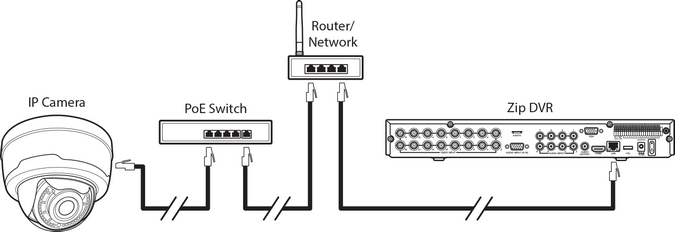When adding IP cameras to a DVR you will need to connect them via a network switch. There are various ways you could do this as listed below:
Direct Connection
You can connect the network switch directly into the LAN port on the rear of the DVR. You can also connect the switch to your router for remote viewing as shown in the External Switch example.

Direct To Your Router
Most routers have a multiple network sockets, this gives you the option of connecting your cameras and DVR directly to the router. Once you have networked your DVR you will able to find you cameras as described in the Searching For IP Cameras section as long as your cameras and DVR are on the same subnet. For more information on networking you DVR see the Network Menu section.
Note: Some routers are limited in terms of bandwidth per port so this needs to be taken into consideration. On larger systems the best way to guarantee performance is to use an external Gigabit switch as shown in the External Switch example.

External Switch
The most flexible option is us to use one or multiple network switches. You would connect you cameras to a switch and then connect the switch to your network or router. To Guarantee performance on larger systems we recommend using Gigabit switches so that there is enough bandwidth for the large volume of cameras.
Once you have networked your DVR you will able to find you cameras as described in the Searching For IP Cameras section as long as your cameras and DVR are on the same subnet. For more information on networking you DVR see the Network Menu section.

PoE & Non-PoE Switches
You have 2 choices when it comes to network switches, PoE or Non-PoE.
PoE (Power Over Ethernet)
PoE switches offer the easiest installation solution as they power the camera over the network cable so a single cable caries the power and data.
Non PoE
Non PoE switches only carry the data down the network lead so you would still need to power the cameras locally.
PoE Range
Traditionally PoE works on cable runs up to 100m. You can, however, achieve greater distances using PoE extenders if required.
PoE extenders boost the PoE range an additional 100m. You can use up to 2 single channel PoE extenders on a cable run for a maximum PoE range of 300m. PoE extenders are passive so they don't require any external power source.
Some PoE switches have built-in range extenders which can boost the PoE range up to 200m without the use of an external PoE extender.